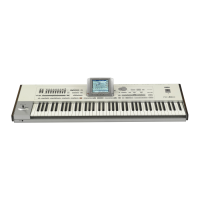149
Pad Record mode
Main page - Guitar Mode
Reference
Main page - Guitar Mode
While in the main page, and a Guitar track has been selected,
touch the “Guitar Mode” tab to see this page. This is where you
can access Guitar Mode programming:
Note: To access this page, a Guitar track must first be selected (see
“Track Type” on page 156). Otherwise, the Guitar Mode tab will
remain grey (not selectable).
Note: When programming a Guitar track from an external
sequencer, you must be sure the Guitar tracks is associated to the
right channel. Go to the Global > MIDI > MIDI IN Channels page,
and assign the corresponding Style track (usually Acc1 ~ Acc5) to
the same channel of the Guitar track on the external sequencer.
Then, go to the Style Record > Style Track Controls > Type/Ten-
sion/Trigger page, and set the track as a track of type “Gtr” (see
“Track Type” on page 156).
Guitar Mode allows to easily create realistic rhythm guitar parts,
without the artificial, unmusical playing typical of MIDI pro-
gramming of guitar parts. Just record a few notes, and you will
end up with realistic rhythm guitar tracks, where each chord is
played according to its real position on the guitar, and not gener-
ated by simply transposing a written pattern.
Recording overview
Recording a Guitar track is unlike the other tracks, where you
play the exact notes of a melody line. With Guitar tracks you play
the keys corresponding to the strumming modes, or play an
arpeggio by using the keys corresponding to the six strings (and
the special keys corresponding to the root and fifth notes). The
following sections describe the various control keys.
Recording strumming types
The octave from C2 to B2 is devoted to selecting a strumming
type. By pressing these keys, you play fast strumming samples:
Recording single strings
The octave from C3 to B3 is devoted to selecting a single string
(or more than one) for playing arpeggios or power chords. You
can either play a free arpeggio with the six guitar chords assigned
to the C~A keys, or play one of the faster sampled arpeggios on
the higher keys. The root note is always available on the C# key,
while the fifth note is always assigned to the D# key; with them,
you can always play the lowest notes of an arpeggio. This octave
also includes an ‘all mute’ key (F#):
Full Up
Full Down Mute
Full Up Mute
Full Down
Full Down Mute Body
Full Down Slow Mute
Full Up Slow
Full Down
Slow
Up 4-Strings
Down 4-Strings
Down Mute 4-Strings
Up Mute 4-Strings
IV String (D)
V String (A) II String (B)
Down/Up 4-Strings
Full Down/Up
All Mute
VI String (E)
III String (G)
I String (e)
Root
Fifth Power Chord

